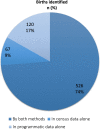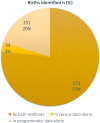Comparing two data collection methods to track vital events in maternal and child health via community health workers in rural Nepal
- PMID: 35897038
- PMCID: PMC9327361
- DOI: 10.1186/s12963-022-00293-4
Comparing two data collection methods to track vital events in maternal and child health via community health workers in rural Nepal
Abstract
Background: Timely tracking of health outcomes is difficult in low- and middle-income countries without comprehensive vital registration systems. Community health workers (CHWs) are increasingly collecting vital events data while delivering routine care in low-resource settings. It is necessary, however, to assess whether routine programmatic data collected by CHWs are sufficiently reliable for timely monitoring and evaluation of health interventions. To study this, we assessed the consistency of vital events data recorded by CHWs using two methodologies-routine data collected while delivering an integrated maternal and child health intervention, and data from a birth history census approach at the same site in rural Nepal.
Methods: We linked individual records from routine programmatic data from June 2017 to May 2018 with those from census data, both collected by CHWs at the same site using a mobile platform. We categorized each vital event over a one-year period as 'recorded by both methods,' 'census alone,' or 'programmatic alone.' We further assessed whether vital events data recorded by both methods were classified consistently.
Results: From June 2017 to May 2018, we identified a total of 713 unique births collectively from the census (birth history) and programmatic maternal 'post-delivery' data. Three-fourths of these births (n = 526) were identified by both. There was high consistency in birth location classification among the 526 births identified by both methods. Upon including additional programmatic 'child registry' data, we identified 746 total births, of which 572 births were identified by both census and programmatic methods. Programmatic data (maternal 'post-delivery' and 'child registry' combined) captured more births than census data (723 vs. 595). Both methods consistently classified most infants as 'living,' while infant deaths and stillbirths were largely classified inconsistently or recorded by only one method. Programmatic data identified five infant deaths and five stillbirths not recorded in census data.
Conclusions: Our findings suggest that data collected by CHWs from routinely tracking pregnancies, births, and deaths are promising for timely program monitoring and evaluation. Despite some limitations, programmatic data may be more sensitive in detecting vital events than cross-sectional census surveys asking women to recall these events.
Keywords: Community health workers; Maternal and child health; Vital events; mHealth.
© 2022. The Author(s).
Conflict of interest statement
A. Tiwari and A. Thapa are employed by a US-based nonprofit (
Figures
Similar articles
-
Can Community Health Workers Report Accurately on Births and Deaths? Results of Field Assessments in Ethiopia, Malawi and Mali.PLoS One. 2016 Jan 5;11(1):e0144662. doi: 10.1371/journal.pone.0144662. eCollection 2016. PLoS One. 2016. PMID: 26731544 Free PMC article.
-
An integrated community health worker intervention in rural Nepal: a type 2 hybrid effectiveness-implementation study protocol.Implement Sci. 2018 Mar 29;13(1):53. doi: 10.1186/s13012-018-0741-x. Implement Sci. 2018. PMID: 29598824 Free PMC article.
-
Comparison of pregnancy and neonatal outcomes in a retrospective full pregnancy history survey versus population-based prospective records: a validation study in rural Sarlahi District, Nepal.J Health Popul Nutr. 2023 Dec 8;42(1):139. doi: 10.1186/s41043-023-00472-5. J Health Popul Nutr. 2023. PMID: 38066542 Free PMC article. Clinical Trial.
-
Community surveillance and response to maternal and child deaths in low- and middle-income countries: A scoping review.PLoS One. 2021 Mar 16;16(3):e0248143. doi: 10.1371/journal.pone.0248143. eCollection 2021. PLoS One. 2021. PMID: 33725013 Free PMC article.
-
Care prior to and during subsequent pregnancies following stillbirth for improving outcomes.Cochrane Database Syst Rev. 2018 Dec 17;12(12):CD012203. doi: 10.1002/14651858.CD012203.pub2. Cochrane Database Syst Rev. 2018. PMID: 30556599 Free PMC article.
Cited by
-
Community-based mortality surveillance among internally displaced vulnerable populations in Banadir region, Somalia, 2022-2023.Front Public Health. 2025 Apr 9;13:1582558. doi: 10.3389/fpubh.2025.1582558. eCollection 2025. Front Public Health. 2025. PMID: 40270735 Free PMC article.
-
A Type II hybrid effectiveness-implementation study of an integrated CHW intervention to address maternal healthcare in rural Nepal.PLOS Glob Public Health. 2023 Jan 24;3(1):e0001512. doi: 10.1371/journal.pgph.0001512. eCollection 2023. PLOS Glob Public Health. 2023. PMID: 36963046 Free PMC article.
References
-
- Corsi DJ, Neuman M, Finlay JE, Subramanian S. Demographic and health surveys: a profile. Int J Epidemiol. 2012;41(6):1602–1613. - PubMed
-
- UNICEF. Multiple Indicator Cluster Survey (MICS): UNICEF; [updated 2014 October 23. https://www.unicef.org/statistics/index_24302.html.
Publication types
MeSH terms
Grants and funding
LinkOut - more resources
Full Text Sources
Medical





